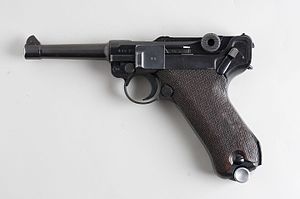Luger pistol
| Luger P08 (Parabellum) | |
|---|---|

Luger P08
|
|
| Type | Semi-automatic pistol |
| Place of origin | German Empire |
| Service history | |
| In service |
German Empire (1904–1918) Weimar Republic (1919–1933) Nazi Germany (1933–1945) Switzerland (1900–early 1970s) Other countries (1900–present) |
| Used by | See Users |
| Wars |
World War I German Revolution Spanish Civil War World War II Second Sino-Japanese War Indonesian National Revolution Chinese Civil War Vietnam War (limited use) Rhodesian Bush War |
| Production history | |
| Designer | Georg J. Luger |
| Designed | 1898 |
| Manufacturer | Deutsche Waffen und Munitionsfabriken, Imperial Arsenals of Erfurt and Spandau, Simson, Krieghoff, Mauser, Vickers Ltd, Waffenfabrik Bern |
| Unit cost | $13 or 32 RM |
| Produced | 1900–1942 |
| Specifications | |
| Weight | 871 grams (1.92 pounds) |
| Length | 222 mm (8.74 in) |
| Barrel length | 95–200 mm (3.74–7.87 in) |
|
|
|
| Cartridge |
7.65×21mm Parabellum 9×19mm Parabellum .45 ACP (very rare) |
| Action | Toggle-locked, short recoil |
| Rate of fire | 20 RPM |
| Muzzle velocity | 350–400 m/s (1148–1312 f/s; 9mm, 100 mm barrel) |
| Effective firing range | 50 m (9mm, 100 mm barrel; short barrel) |
| Feed system | 8-round detachable box magazine, 32-round detachable drum |
| Sights | Iron sights |
The Pistole Parabellum 1908—or Parabellum-Pistole (Pistol Parabellum)—is a toggle-locked recoil-operated semi-automatic pistol. The design was patented by Georg J. Luger in 1898 and produced by German arms manufacturer Deutsche Waffen- und Munitionsfabriken (DWM) starting in 1900 with other manufacturers such as W+F Bern, Krieghoff, Simson, Mauser, and Vickers; it was an evolution of the 1893 Hugo Borchardt–designed C-93. The first Parabellum pistol was adopted by the Swiss army in May 1900. In German Army service, it was succeeded and partly replaced by the Walther P38 in caliber 9×19mm Parabellum.
The Luger is well known from its use by Germans during World War I and World War II, along with the interwar Weimar Republic and the postwar East German Volkspolizei. Although the P.08 was introduced in 7.65mm Parabellum, it is notable for being the pistol for which the 9×19mm Parabellum (also known as the 9×19mm Luger) cartridge was developed. Because of its association with Nazi Germany, the pistol has been used in fictional works by many villainous characters over the past several decades.
One of the first semi-automatic pistols, the Luger was designed to use a toggle-lock action, which uses a jointed arm to lock, as opposed to the slide actions of almost every other semi-automatic pistol. After a round is fired, the barrel and toggle assembly (both locked together at this point) travel rearward due to recoil. After moving roughly 13 mm (0.5 in) rearward, the toggle strikes a cam built into the frame, causing the knee joint to hinge and the toggle and breech assembly to unlock. At this point the barrel impacts the frame and stops its rearward movement, but the toggle assembly continues moving (bending the knee joint) due to momentum, extracting the spent casing from the chamber and ejecting it. The toggle and breech assembly subsequently travel forward under spring tension and the next round from the magazine is loaded into the chamber. The entire sequence occurs in a fraction of a second. This mechanism works well for higher-pressure cartridges, but cartridges loaded to a lower pressure can cause the pistol to malfunction because they do not generate enough recoil to work the action fully. This results in either the breech block not clearing the top cartridge of the magazine, or becoming jammed open on the cartridge's base.
...
Wikipedia
